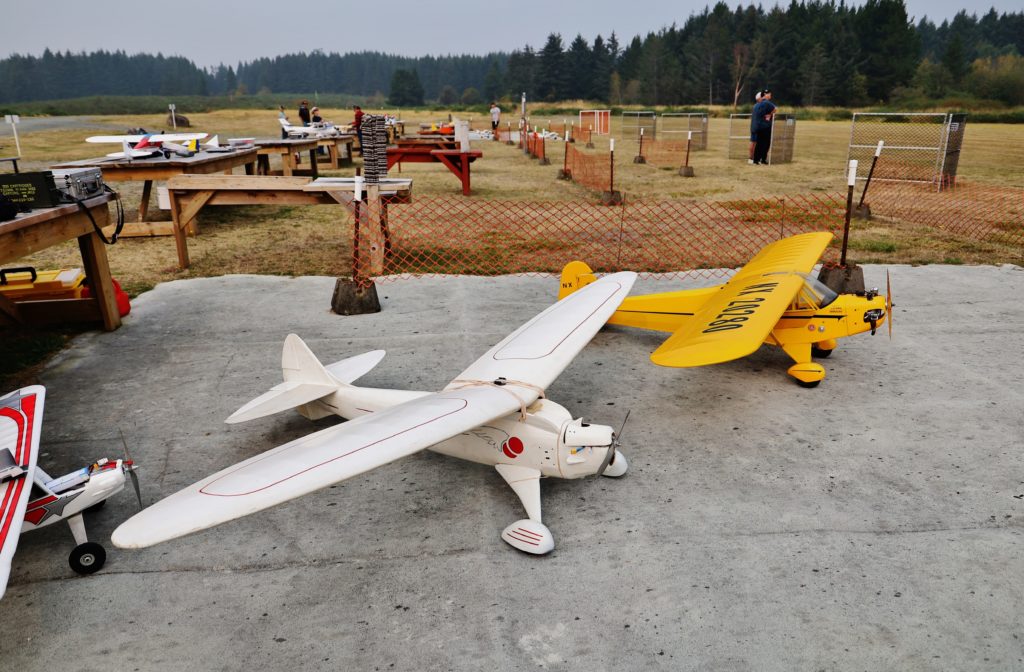Estimated reading time 7 minutes, 30 seconds.
Members of the Parksville District and Qualicum Flyers share a passion for aviation through their radio-controlled aircraft club in British Columbia. Geoff Graham is one example of the devotion to the club, known as PDQ Flyers, underscoring the popularity of flying model planes and helicopters in Canada.
To get a flavour of the enthusiasm for the hobby, look no further than a grass field located near Parksville on Vancouver Island. During the pandemic, even though there are much fewer of the club members participating at any given time, some dedicated participants continue to pursue their hobby from physically distanced tables placed on the field.

After taking a break at the start of the pandemic in March of 2020, Graham resumed flying his collection of model aircraft last June. Others who have decided to suspend their flying activities still work on their model aircraft at home.
Graham, now 73, had a varied career in aviation before he retired a decade ago. He flew as a pilot during his time with the Royal Canadian Air Force for 26 years; worked for 13 years for Transport Canada; and even ran a flying school for a couple of years in Qualicum Beach, located near Parksville.
As he moved around with the military, he found other people who were interested in model planes. “You would find out the local field, and away we would go,” said Graham.
While there is a wide age-range of members who belong to PDQ Flyers, many are retirees who were cautious about returning to the field for flying. “Most people decided to take some time off until the COVID rules got firmed up,” he said. “We’ve got a lot of older folks.”
The club has nearly 100 members who come from all walks of life. And while having experience in the flight deck is not unusual, many PDQ Flyers have no past history in the aviation industry.
“There is some correlation between having done it in real life in full scale, and flying model airplanes,” said Graham. “But this one fellow is a friend of mine, a retired realtor, he flies fine. He flies great. So, you don’t need to have flown a full-size airplane to be good at radio control.”
Club president Greg Brunt said just as the members’ backgrounds vary widely, so do the types of model aircraft they fly. Those models include a Pilatus PC-21 with a wingspan of 59 inches (150 centimeters) from one tip to the other, and a SIG LT-40 with a wingspan of 70 inches (178 cm). Different models have a wingspan of only seven inches (18 cm), while the larger planes boast a wingspan of 11 feet (3.4 meters).
Beginners can use “almost ready-to-fly” kits to get started for $250 each, but the hobby also entices experienced flyers to spend at least $1,500 for a fancier kit.
“There are many sizes and intricacies as you get better. My transmitter alone is $600,” said Brunt.
On some occasions during the pandemic, a dozen club members might show up at the field, being careful with safety protocols to make room — with one person leaving as someone else shows up.
Before the pandemic, there could be 25 flyers on the field during special events, including serving hot dogs as part of the socializing.
Prime flying season is in the summer, though many of the keener members of PDQ Flyers like to keep active during the spring and autumn, too.
Indoor gatherings for the club have been cancelled, but if vaccinations go smoothly in British Columbia, Brunt is hoping to hold a special event outdoors, possibly in September.
Brunt, 73, is among the hobbyists who doesn’t have an aviation background. He formerly worked as a sales manager at a lumber company. In retirement, his routine includes assembling and flying model planes. He has 14 model aircraft, with another 10 in various stages of progress.
Many members have at least seven or eight aircraft in their collection, and some have even more than Brunt’s total of 24 — either finished or in some phase of being built. PDQ Flyers vice president Allan Macmillan is a former public sector and small business consultant. He is a former recreational pilot who enjoys flying model aircraft, boasting a collection of 42 planes, including three kits that he’s working on this spring.
PDQ Flyers is affiliated with the non-profit Model Aeronautics Association of Canada (MAAC).
“From flying just for fun to world-class competition, we provide a common theme of safety and general operations that is shared by the hundreds of member clubs across the country,” according to MAAC.
To fly a model plane in Canada legally, hobbyists must be a MAAC member, Macmillan emphasized. He grew up in the Downsview area, north of Toronto. He recalls watching adults in open fields as they flew a type of model glider with a motor attached for short flights, but without remote controls — many years before radio-controlled planes became popular.
“I’ve been fiddling with model airplanes for 63 years,” said Macmillan. “One of my neighbors, when I was 10 years old, made an airplane for me. So that started it.”